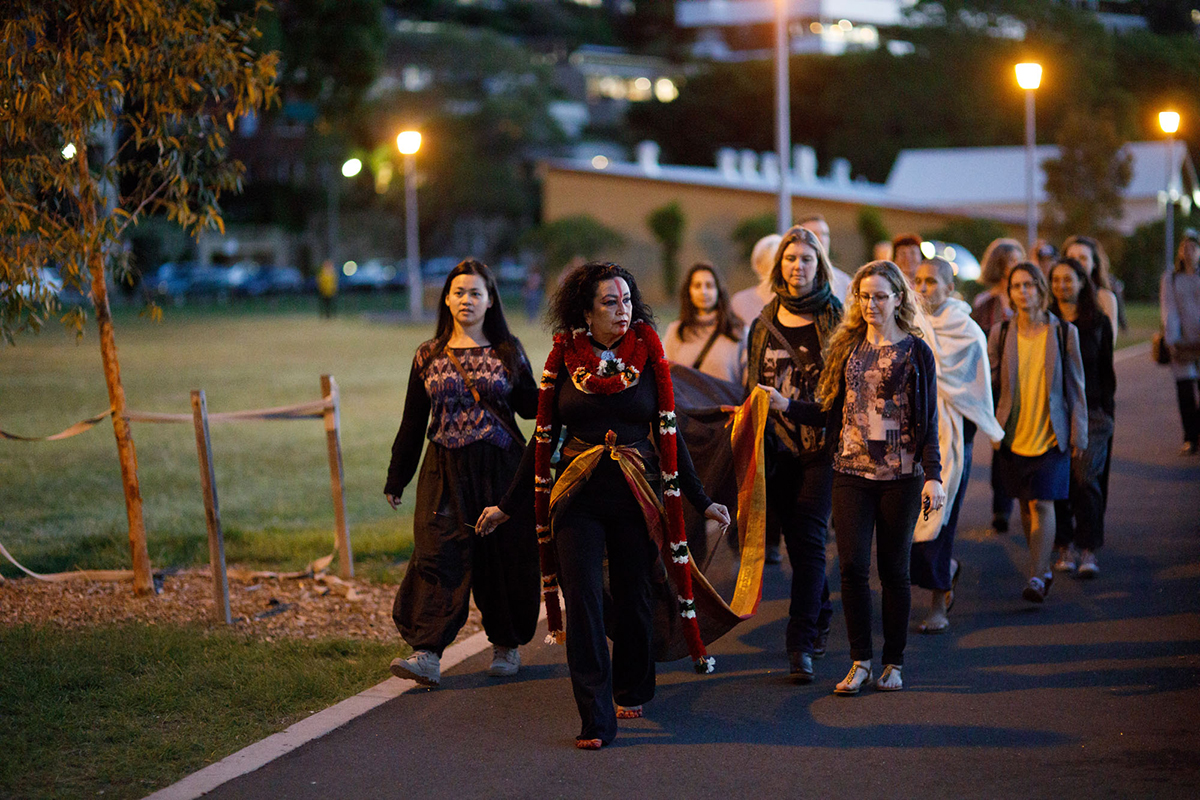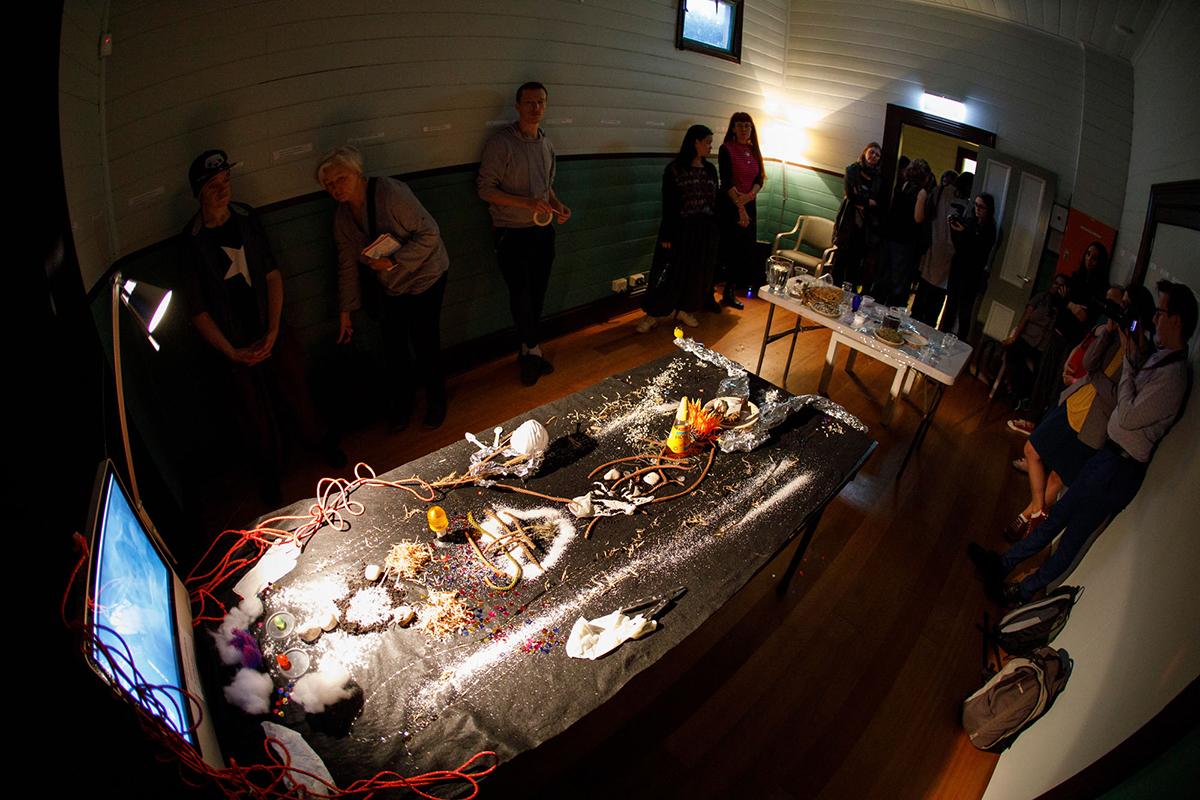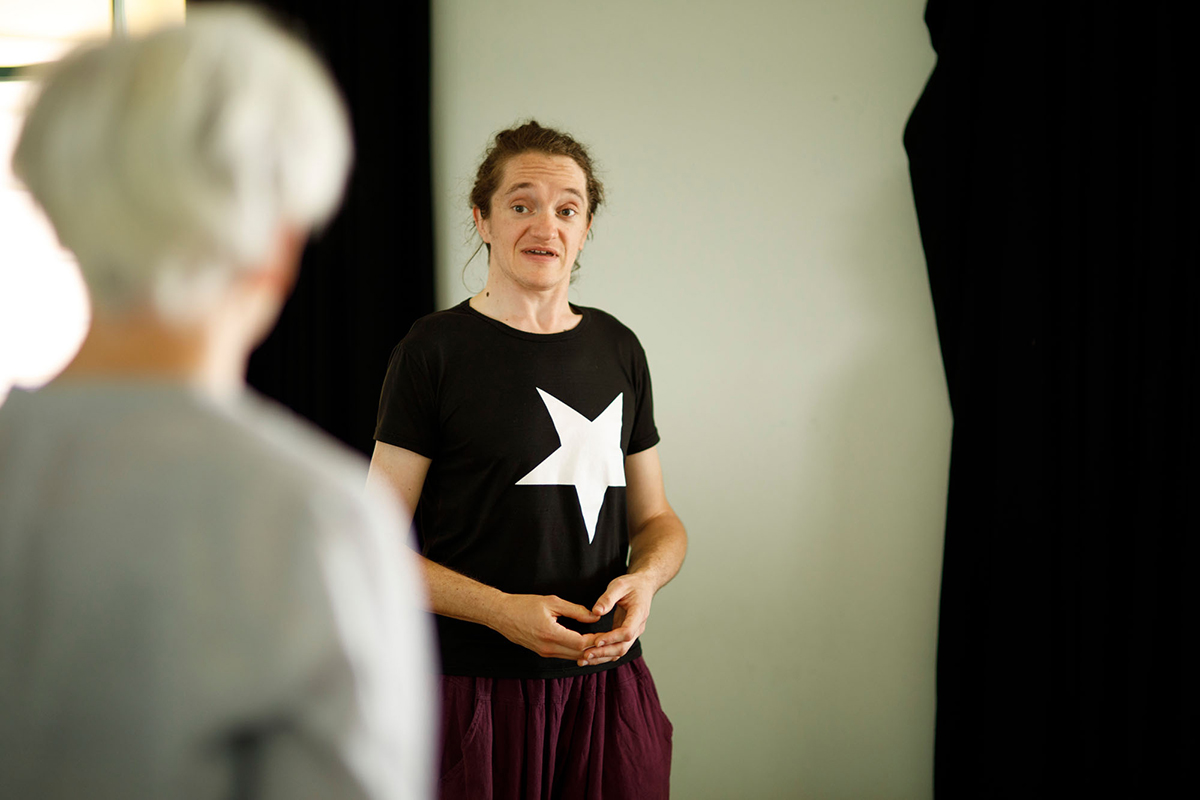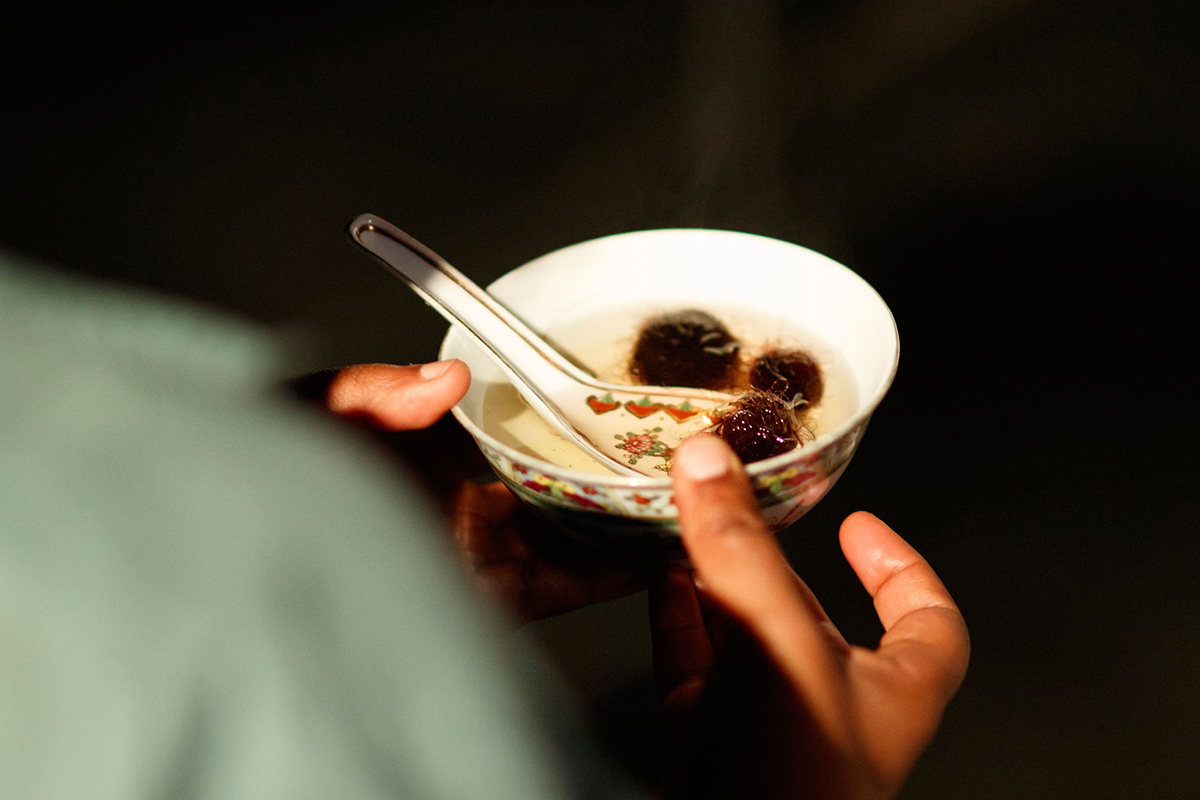
Interchange Festival: The Start and the End of the Body
Critical Path’s Interchange Festival, held over a weekend from Friday evening to Sunday night, invited guests and participants to share experiences of working across and between cultures as part of choreographic practice via forums, workshops, performances and talks by international guests. Cleo Mees reported on the second day, themed The Political Body, while Nikki Heywood focused on the third, The Start and the End of the Body. RT
Where is the body in interdisciplinarity?
Over the course of the third day of Critical Path’s Interchange Festival 2017 we discussed a diverse selection of works, witnessed small showings, participated in workshops and snacked on a veritable degustation of interdisciplinarity: 22 artists/presenters over five sessions and 12 events.
It is true that Mornings are Difficult (the title of Sunday’s first session), especially so when the question “Where is the body in interdisciplinary work?” is posed before the caffeine has kicked in. Our morning convenor dancer Lizzie Thomson instinctively (and wisely) invites us up onto our feet for a short and sweet exercise. We’re asked to place any surface of our body against any in the room where we’re gathered. My senses start to wake up as pathways of sensation, beginning where my forehead is in contact with the doorjamb, spread to spine and limbs, small shifts of my weight suggesting the potential for further movement. Something so simple as the conscious meeting of fleshy and inanimate surfaces is an effective interruption to the normal arrangement of seated or standing bodies, our usual modes of occupying social place and time. This short awareness task somehow sets the tenor of the day, where the intelligent vehicles of our bodies and our bodily senses are foregrounded as the surface of interchange between self and other, be that other objects, environments, cultures, stories, systems…
Back in a seated position, alert for conversation, Lizzie makes a short introduction to interdisciplinarity. Describing her experience of being a living/talking book in the Newtown Library for the 2016 Biennale of Sydney in Mette Edvardsen’s time has fallen asleep in the afternoon sunshine, Thomson riffs on being subject to the tidal rhythms of Virginia Woolf’s The Waves. The “pauses of forgetting” and then the feeling of “words rushing toward” her, highlight for Thomson the “magical force of memory” as well as the labour of embodying and conveying language and the kinetic quality of remembered story.
The theme of the kinesis of language continues as performance-maker Brian Fuata plays on bringing together his parallel practices of ghostliness — where he literally occupies space in various venues covered in a sheet — and his more remote email performances, where curtains of text rise and fall on a scrolling page for an audience in isolated darkness as BCC (blind carbon copy) recipients. Here in the morning sunlight, framed by the open double doors against a backdrop of swaying masts in the harbour, Fuata stands wavering on one leg, interrupting his own stories about performing and accidents, as his ghostly white sheet and large pieces of paper are lifted by the wind. Notions of ephemerality underlined by his descriptions of what might happen are such that I drift in the vestiges of possibility, glimpsing the ghost of a performance that may never appear.

Missing body construction instigated by Joshua Pether, Interchange Festival 2017, Critical Path, photo Matthew Syres
What is the body?
The session continues with two breakaway groups (about eight people in each) tasked to tackle the morning’s question headlong. Our group’s captain Justine Shih Pearson lobs a small grenade; she asks us to consider “What is the body?” Ouch! More coffee anyone? In contemplating the different conditions in which we ascribe its value and whether indeed there is a shared consensus on the nature of the body, I quietly ruminate on why we use the distancing and generic definite article for ‘the’ body? Why not a body, my body, our body? How does our language determine our proximity to the subject in the terms under discussion, such as vulnerability and care? Does the general term “the body” reduce our complexity and objectify our understanding of what it is to be human? We duck and weave amid unsettling notions, pondering the uncertainty of bodies impacted by the forces of power and labour. The tantalising threads of content that we generate are impossible to contain in the short time available to us.
For me, the profusion of thoughts echoes Lizzie Thomson’s earlier proposition of “story as excess,” connecting with threads of my own thinking and research around dance and creativity more broadly as a form of excess. Not in terms of waste product but rather, at times, as an offering or outpouring, even a gift to be bestowed. The creativity that Australian philosopher Elizabeth Grosz refers to in Chaos, Territory and Art: Deleuze and the Framing of the Earth (2008) as the excess of our (and other animals’) being. As to the overarching question “Where is the body in interdisciplinary work?” I also wonder if interdisciplinarity is something existing in the body of the viewer. As a consumer of less determinate forms of art practice, I may be called upon to harness my own understanding of history and its codes, my visual acuity, my ability to listen and translate sound and language, my sense of touch and empathy for movement and, possibly primarily, my willingness to suspend knowing and desire for certainty. The synthesis of disparate elements, or crossover of inter-related disciplines, takes place in my body, your body, our bodies, as we participate in art as a form of exchange.
The body on-site
Our next session continues the theme of interdisciplinary work, as architectural theorist, designer and UNSW Art & Design Senior Lecturer Sam Spurr facilitates a conversation between performance ensemble Branch Nebula (Mirabelle Wouters and Lee Wilson) and Rochelle Haley, an artist and researcher working with experimental drawing, movement and spatial performance practice. The common link between these artists is their work in site specific contexts, often with untrained performers; Branch Nebula have worked in shopping centres and skate parks, while for Afterglow, Haley used an empty gallery as a site.
Wilson and Wouters have taken the choreography of skateboarding, BMX-riding, parkour and dance into the realm of the virtuosic and along the way struggled with the paradox of locking out locals from the park, while they make art with the express intent of community inclusion. They have actively engaged with this problem to develop strategies of infiltration, gaining acceptance and subtly challenging territorialism by involving local park users and infecting them with the spirit of collective creation. They embrace anarchic tendencies by making improvised performance with whoever is there.
Haley’s strategies are of a more overtly aesthetic nature. She enlists young Physical Education participants to create a type of expanded painting across a space with moving bodies attending to line, colour and drape of cloth; filling and emptying rooms and corridors with simple choreography, movers and viewers all wearing the same pale mantle of costume. While Branch Nebula and Rochelle Hayley are mutually interested in collectives and bringing people together, and perhaps — Spurr introduces the term — in “the care of looking” and audience behaviours, I am most struck and amused by the stark contrast between Branch Nebula’s gritty, sweating, risk-taking bodies and the apparent cool effortlessness of Haley’s timeless, gliding maidens.
Philippe Blanchard: sensitivity to proximity
Our post-lunch convenor Adelina Larsson introduces two international artists. Sweden-based French choreographer Philippe Blanchard outlined the parameters of his current project, also in terms of bringing bodies closer together. He is generally interested in the experience of migration and uncertainty, literally reflecting destabilisation through practices such as jumping and shaking to exhaustion. Scale and space in Australia provoke questions for him that relate to synchronising impulse and sensitivity to proximity, describing how doing away with the sense of his own body as a personal entity has led him to ask rather, “How do our bodies function together?” This inquiry seems to readdress concerns that have been investigated by practices such as BodyWeather, Body Mind Centering and Contact Improvisation among others across decades.
I-Chin Lin: language unleashed into dance
Taiwanese dancer I-Chin Lin speaks about the recovery of her culturally suppressed ancestral language, when at the age of 26 she experienced heartbreak and found herself swearing in her native Holo. The cathartic explosion of energy brought about what she describes as a connection to her core and to something fundamental to her own culture. For I-Chin the energetic force of passionately expressed language allowed her to newly identify the distinct character of her Taiwanese-ness, such as the inter-related qualities of humidity and the salty sweet nature of Taiwanese cuisine. The inner and outer climates as conditions of influence, embedded in the sound and feel of Holo language, now infuse her choreography in subtle ways. It was refreshing to hear about an artist, triggered by a visceral life event, turning inward to savour the nuances of her own culture. This highlights the tendency of many of us, myself included, who have scanned and sampled the depths of exotic art forms that are not our own, which can of course by its problematic nature be quite creative… notwithstanding our capacity for integration and hybridisation.

Matt Shilcock, Interchange Festival 2017, Critical Path, photo Matthew Syres
Matt Shilcock: The bones of truth
The late afternoon offerings are less talk, more action but here, as always with parallel sessions, the problem is making a choice, with the inevitable FOMO.
Having had a brief chat with Adelaide artist Matt Shilcock about alchemy and essences, I found his session, Osteogenuine – Alchemia Exteriores, intriguing. His own story of transformation, from wheelchair and a propensity for broken bones, to martial arts and the dance floor as a way of staying alert to his body’s capacity, is inspiring. He is interested in how desire and intent can inform his own and others’ embodiment and ensuing choreographic patterns. I marvel at how his circumstance and awareness of his own bony anatomy has carved his approach to conceptual structures, reinforcing the ways in which the architectures of body and mind are intrinsically entwined. I enjoy hanging out in the unknown, in a room with a young choreographer who is finding ways to simultaneously articulate and evolve his process.
To the session’s task. Each of us distils a statement of intent down to an absolute sentence, which is then deconstructed by creating a pattern across a circular arrangement of letters (an alphabetical clock or prima figura) transposed over a diagram of Leonardo’s Vitruvian man. In this way we configure our own 3D movement score in a process that is both mysterious and pragmatic. I am reminded of Surrealist procedures that rely in part on chance, in part on assemblage, as I swing my right outstretched Vitruvian arm from letter N at 10 o’clock diagonally across to Y at 2.30 while lifting left foot from the central V at 6 to G at 4ish, and other variations on that theme. As in alchemy there is a combination of the abstract and the concrete in such processes that I find appealing. Mostly I am left with the memory of Matt Shilcock stating that he is “not so interested in being seen” but in engaging with the osteo genuine or the bones of truth.

Julie Vulcan, Weizen Ho, Interchange Festival 2017, Critical Path, photo Matthew Syres
Performances: exchange, alchemy & ritual
In the curated evening session Julie Vulcan presents six artists under the title Continuity. Transgression. Interruption. Two of the artists are not present, their work shown in absentia. However, dancer Kathryn Puie and Lux Eterna using live camera and projection are in the building and fully fleshed. Their field of enquiry circles the ambiguity of prosthetics and their use to enhance capacity or to replace what is missing, and they propose that prosthetics are already ubiquitous in our lives in the form of spectacles, appliances, furniture, even cars. When Kathryn straps on her stilts and Lux her steadycam apparatus and they take over the space, they demonstrate, via shifting speeds, proximities and angles, the potential for exchange enabled by their individual prostheses. I was particularly interested in the video document showing them both blindfolded, taking the sighted camera for a walk, and also Lux’s developing facility to follow movement with her camera through enhanced awareness of her own body shifts and adjustments in dialogue with her ocular attachment.
Engaging in another kind of alchemy, indeed sorcery, Vulcan presents absent performer Weizen Ho’s work. Vulcan and Ho share an interest in hair as both debris and artefact for rituals of grief and memory. In this instance we are served with Chinese bowls containing a blend of tea and a tightly wound hair ball (blatantly disguised to look like tea) which connects to a ritual involving a slowly brewed herbal concoction that mothers and their children partake in after arguing. There is something of the abject in this offering that elicits a mix of disgust and curiosity in those assembled. Who will partake? As I tentatively sip, a person nearby asks, “How is it? Taste like forgiveness?’ Hmmm…more like green tea shampoo.
In a room upstairs. Alison Pevey, accompanied by the curtained darkness, a rumble of low sound and then a flood of natural light through the window, employs her “body as site” to bring attention to global and human energy cycles. As she expands and contracts in building waves of motion toward a short explosion and then exhaustion, I ponder the evident futility for Pevey as a single body/human to speak of excess and consumption. The collective of bodies stand idly at the sidelines while the cycle continues.
In the next room, the absent artist Joshua Pether is represented by a video screen displaying an x-ray of a spine affected by scoliosis as a kind of headstone atop a slab-like table. We are invited to read aloud the fragments of his text that forms a frieze around the walls, and then to construct the missing body out of an array of available ingredients. Cotton wool, stones, wire, a small light, bright plastic objects, organic things are all arranged by us, the collective, into a spontaneous humanoid assemblage to the repeating distortions of Kate Bush’s “Wuthering Heights” and white noise. I was reminded of William Forsythe’s more sophisticated participatory work seen in Berlin, 2005 where “You made me a monster” involved a hanging cardboard anatomical assemblage and the tracing of the moving shadows. Like Forsythe, Joshua Pether evoked a sense of memorial and an energetic ritual dispersal of grief.
For the day’s finale and in the fading light, Rakini Devi is laid out ceremoniously in black beside a long piece of cloth that stretches almost the entire length of the Drill Hall. There is an ambient gurgling sound and I am drawn to the blood-red stain on her feet, chin and décolletage. An undulating movement rises in her torso and Devi begins her slow worm-like passage up the space. Her obeisant form rises at the end to invoke the spirit of Shiva in a short series of words and gestures before turning with a lifting of the cloth that now becomes her long train. We form her retinue and fall in line to carry the diaphanous cloth out into the evening air and further still some 250 metres to a jetty. I have little idea what this ritual signifies, but the soundtrack now is of bird call, clanging masts and voices of fishermen. Finally Devi/Shakti turns, her face wrapped in a red flower garland, and walks blindly toward us back up the rocking jetty. Not your usual Sydney Sunday by the harbour, beginning with a white-sheeted babbling ghost and finishing with a dark queen of the night — the start and end of the/my/your/our body are slippery co-ordinates.
–
Critical Path, Interchange Festival 2017, The Start and the End of the Body; Drill Hall, Sydney, 12 Nov
Nikki Heywood’s response to The Start and the End of the Body was jointly commissioned by Critical Path and Open City, the publisher of RealTime.
Top image credit: Rakini Devi, Interchange Festival 2017, Critical Path, photo Matthew Syres






